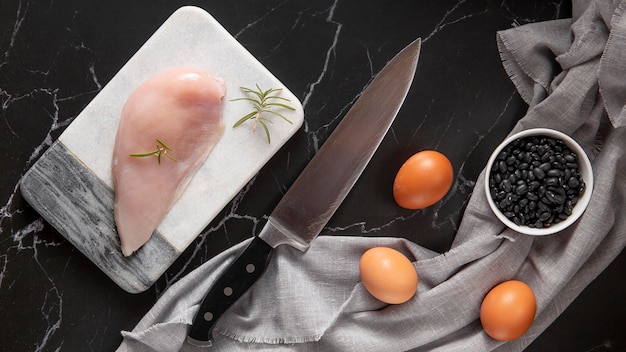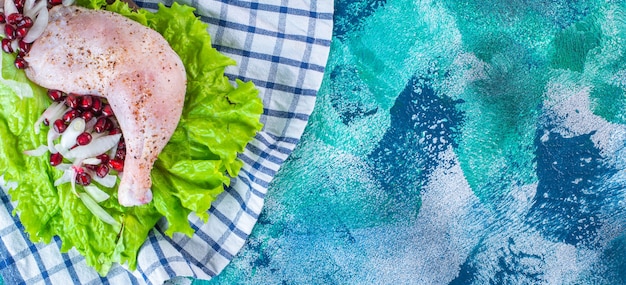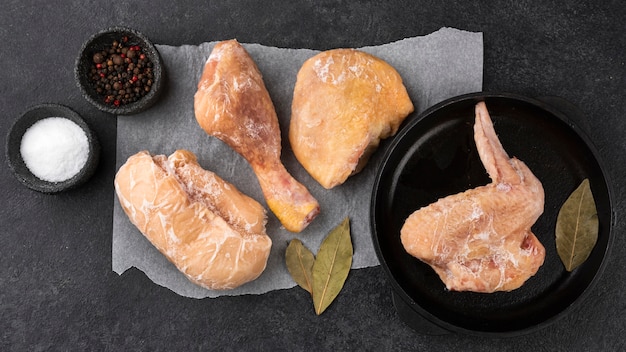Let's face it, we've all been there. Staring into the abyss of our empty fridge, the dreaded dinnertime looming, and all we've got is a bag of frozen chicken breasts. The thought of bland, dry, rubbery chicken fills us with dread. But fear not, my fellow cooks! I'm here to tell you that frozen chicken breasts can be your culinary saviour, with a little know-how and some simple tricks, you can transform those seemingly uninspiring frozen lumps into delicious, juicy, and satisfying meals. So grab a cuppa, settle in, and let me share my wisdom, gleaned from years of battling the freezer aisle and emerging victorious with a plate of perfectly cooked chicken.
Part 1: The Frozen Chicken Dilemma

The Challenges of Frozen Chicken
I've been there, staring at a bag of frozen chicken breasts, wondering how on earth I'm going to turn them into something edible. The biggest challenge, of course, is the dreaded dryness. Those frozen breasts can easily become tough and flavourless if not cooked properly. Imagine biting into a piece of chicken that feels like chewing on a rubber band – not exactly a delightful dining experience! Another hurdle is the time it takes to defrost. We're all busy, and waiting around for the chicken to thaw can feel like an eternity, especially when hunger pangs are setting in. Then there's the question of taste. Frozen chicken can sometimes lack the vibrancy of fresh, so we need to find ways to bring out the flavour and make it sing.
Why Frozen Chicken Can Be a Good Choice
Despite the challenges, frozen chicken has some definite advantages. First, it’s incredibly convenient. You can stock up on it and it keeps for ages, meaning you’ll always have a protein option on hand, even when you’ve forgotten to grab groceries on your way home. It’s also generally cheaper than fresh chicken, which is a huge bonus for budget-conscious cooks like myself. Plus, it can be a real lifesaver when you forget to buy groceries or simply can’t face the supermarket crowds on a busy Saturday morning. Those frozen chicken breasts are like a culinary safety net, ready to save the day when inspiration (and fresh food) is lacking.
Part 2: Mastering the Defrosting Game

The No-Nos of Defrosting
Okay, so you’ve got your bag of frozen chicken. Now what? Resist the urge to ‘rush’ the defrosting process. Never, ever defrost chicken at room temperature. It's a recipe for bacterial growth and food poisoning, and trust me, you don't want to be dealing with that. Similarly, avoid using hot water – it can lead to uneven cooking and a soggy texture, which is just as bad as dry chicken. We're aiming for juicy, delicious chicken, not a soggy mess!
Safe and Effective Defrosting Methods
There are a few tried and true methods for safely defrosting frozen chicken, each with its own pros and cons. Choose the one that best suits your needs and time constraints:
- The Fridge Method: The most common (and safest) way to defrost frozen chicken is in the refrigerator. This method is my personal favourite. Simply pop the bag of chicken in your fridge, and it should defrost in about 24 hours, give or take a few hours depending on the size of the breasts. Always place the chicken on a plate to catch any drips and ensure it’s on a lower shelf, below any other food items, to avoid any cross-contamination. This method might take a while, but it’s worth it for the peace of mind it offers.
- The Cold water bath: If you’re short on time, you can defrost chicken in a cold water bath. This method is a bit quicker than the fridge, but requires a little more attention. Place the bag of chicken in a large bowl of cold water, making sure the water is completely covering the chicken. Change the water every 30 minutes to ensure it stays cold, preventing bacterial growth. This method should take about 30 minutes per pound of chicken. Keep an eye on the time, as you don't want to leave the chicken in the water for too long.
- The Microwave Method (with caution): If you’re in a real pinch, you can use the defrost setting on your microwave. However, I use this method sparingly, as it can lead to uneven cooking. If you must use it, stick to small quantities of chicken and keep a very close eye on it. Never defrost chicken in the microwave on high power. This will heat the outside before the inside is thawed, which can lead to bacteria growth. Always cook microwave-defrosted chicken thoroughly to ensure it’s safe to eat.
Part 3: Preparing for Perfection

Don’t Skip This Crucial Step
Even after you’ve successfully defrosted your chicken, there are still a few crucial steps to take before you start cooking. These steps might seem simple, but they make a huge difference in the final result. First, always pat your chicken breasts dry with paper towels. This will help them brown more evenly in the pan and create a beautiful golden crust. Second, season your chicken breasts generously. Salt and pepper are the basics, but feel free to get creative with your spices. I like to add a pinch of garlic powder, paprika, and cayenne pepper for a kick. Third, consider making a marinade. Marinating your chicken breasts in a mixture of oil, vinegar, and herbs for at least 30 minutes will add extra flavour and moisture, making them tender and juicy.
My Favourite Marinade Recipe
Here’s my go-to marinade for frozen chicken breasts. It’s simple, delicious, and works wonders:
- 1/4 cup olive oil – provides moisture and helps the flavours penetrate the chicken
- 2 tablespoons lemon juice – adds a bright, tangy flavour and helps tenderize the chicken
- 1 tablespoon soy sauce – adds a salty, savoury flavour and enhances the browning
- 1 teaspoon garlic powder – adds a pungent flavour and aroma
- 1 teaspoon onion powder – adds a sweet and savoury flavour and enhances the overall taste
- 1/2 teaspoon black pepper – adds a touch of heat and depth
- 1/4 teaspoon dried oregano – adds a slightly bitter and earthy flavour
- 1/4 teaspoon dried thyme – adds a slightly sweet and herbaceous flavour
Simply combine all the ingredients in a bowl, whisk well, and pour over your chicken breasts. Let them marinate in the fridge for at least 30 minutes, or even better, overnight. The longer they marinate, the more flavour they will absorb.
Part 4: Cooking Methods for Every Kitchen
Pan-Frying for Crispy Goodness
Pan-frying is a classic way to cook chicken breasts. It gives them a lovely crispy exterior and juicy interior, perfect for a quick and satisfying meal. Get your pan nice and hot with some oil, but don't let it smoke. Make sure your chicken breasts are completely dry before adding them to the pan. This will help them brown evenly and prevent them from sticking. Cook them over medium-high heat for about 5 minutes per side, or until they’re golden brown and cooked through. Don’t crowd the pan, cook in batches if necessary. This will ensure even browning and cooking. Once cooked, remove the chicken from the pan and let it rest for a few minutes before slicing and serving. This allows the juices to redistribute, resulting in a more tender and flavorful chicken breast.
Baking for a Stress-Free Meal
Baking is a great way to cook chicken breasts when you want a hassle-free option. Preheat your oven to 375°F (190°C). Line a baking sheet with parchment paper or foil for easy cleanup. Place your chicken breasts on the baking sheet and bake for about 25 minutes, or until the internal temperature reaches 165°F (74°C). You can also add a little bit of water to the bottom of the baking sheet to help keep the chicken moist. This creates steam that helps to cook the chicken evenly and prevents it from drying out. Baking is a great option for when you need to cook multiple chicken breasts at once, as it allows you to focus on other tasks while they cook in the oven.
Grilling for a Smoky Flavour
Grilling is a great way to cook chicken breasts if you’re looking for a smoky flavour. Preheat your grill to medium heat. Season your chicken breasts and grill for about 5 minutes per side, or until they’re cooked through. To prevent sticking, make sure your grill grates are clean and lightly oiled. Grilling can be a bit of a dance, so keep a close eye on your chicken to avoid burning. You can create delicious grill marks by rotating the chicken breasts 90 degrees halfway through cooking. Grilling is perfect for summertime meals and adds a delightful smoky flavour that can’t be replicated in other cooking methods.
Slow-Cooking for Tender and juicy chicken
If you’re looking for the ultimate tender and juicy chicken, slow-cooking is the way to go. Place your chicken breasts in a slow cooker with your favourite sauce or marinade. Cook on low for 6-8 hours, or on high for 3-4 hours. The long cooking time allows the chicken to break down and become incredibly tender. You can shred the chicken after cooking and use it in salads, wraps, or sandwiches. Slow-cooking is a great option for busy weeknights, as you can set it and forget it, allowing the chicken to cook while you get other things done. Just remember to set a timer to ensure the chicken doesn’t overcook.
Part 5: Checking for Doneness
Don’t Rely on Guesswork
We’ve all been there, cutting into a chicken breast with a hopeful look on our face, only to find it’s still pink and raw inside. Don’t rely on guesswork, use a meat thermometer to ensure your chicken is cooked through. The internal temperature of cooked chicken should reach 165°F (74°C). If you don’t have a thermometer, you can check for doneness by making a small cut in the thickest part of the chicken breast. If the juices run clear, it’s cooked. If they’re still pink, it needs to cook a bit longer. It’s important to cook chicken to the correct temperature to kill any harmful bacteria that could cause food poisoning.
Part 6: Keeping It Moist and Delicious
The Fight Against Dry Chicken
Dry chicken is a culinary crime, and it’s a common problem with frozen breasts. Here are a few tips to keep your chicken moist and flavorful, making it a dish that everyone will love:
- Don’t Overcook: Overcooking is the biggest culprit when it comes to dry chicken. Cook your chicken breasts until they reach an internal temperature of 165°F (74°C), but no more. Overcooked chicken is tough and dry, so pay close attention to the cooking time and don't let it cook for too long.
- Use a Moisture-Rich Cooking Method: Methods like slow-cooking, braising, and steaming help keep chicken moist by trapping moisture during the cooking process. These methods are particularly effective for frozen chicken breasts, as they help to rehydrate the chicken and prevent it from drying out.
- Add a Little Fat: Adding a little bit of oil or butter to the pan or baking sheet can help keep chicken moist during cooking. The fat helps to create a barrier that prevents moisture from escaping, resulting in a more succulent chicken breast.
- Keep It Covered: Covering chicken while it’s cooking in the oven or on the stovetop can help prevent moisture loss. This creates a steamy environment that helps to keep the chicken moist and tender.
- Rest It: Always let your cooked chicken rest for a few minutes before slicing and serving. This allows the juices to redistribute, ensuring a more tender and flavorful result. While the chicken is resting, the internal temperature will continue to rise slightly, ensuring it’s cooked through.
Part 7: Flavor Hacks for Frozen Chicken
Don’t Be Afraid to Get Creative
The beauty of frozen chicken breasts is that they can be transformed into countless delicious dishes. Frozen chicken is a blank canvas, ready to be transformed into whatever your culinary imagination desires. Here are a few flavour hacks to elevate your frozen chicken game:
- Go Global: Try Indian curry, Thai stir-fry, Mexican enchiladas, or Moroccan tagine. Frozen chicken works wonderfully in global cuisine, adding a touch of protein to dishes from all corners of the world.
- Think Outside the Box: Instead of the usual chicken and rice, try a chicken and quinoa salad with a lemon vinaigrette or a chicken and vegetable stir-fry with a ginger-soy sauce. Get creative and experiment with different flavours and textures.
- Get Savoury: Create a cheesy chicken and broccoli casserole, a chicken pot pie, or a hearty chicken and barley soup. Embrace the comforting flavours of savoury dishes that are perfect for a cold winter night.
- Embrace the Sweet: Try a sweet and sour chicken stir-fry, a honey garlic chicken with roasted vegetables, or a chicken satay with peanut sauce. Explore the sweet side of chicken and create delicious dishes that are both sweet and savoury.
Part 8: Storage and Leftovers
Freezing Cooked Chicken
You can freeze cooked chicken for later use. Just make sure it’s cooled completely and then store it in an airtight container or freezer bag. Frozen cooked chicken should last for up to 3 months in the freezer. It's a great way to save time and prevent food waste. Simply reheat the chicken later for a quick and easy meal.
Reheating Leftovers
To reheat cooked chicken, you can use a microwave, oven, or stovetop. If using the microwave, heat on low or medium power until the chicken is heated through. If using the oven, reheat at 350°F (175°C) until the chicken is warmed through. If using the stovetop, add the chicken to a pan with a little bit of oil or broth and heat over medium heat until warmed through. Avoid over-reheating the chicken, as it can become dry and tough. Reheating should be done gently to ensure the chicken stays moist and flavorful.
Part 9: FAQs
Q: Can I cook frozen chicken directly?
A: It’s not recommended to cook frozen chicken directly. It’s crucial to defrost it properly first. Cooking frozen chicken directly can lead to uneven cooking and potentially foodborne illness. The outside of the chicken might cook before the inside has a chance to thaw, creating a dangerous situation where bacteria can grow. Always defrost your chicken properly to ensure it's cooked through and safe to eat.
Q: How long does it take to defrost frozen chicken?
A: The time it takes to defrost frozen chicken depends on the size of the chicken and the defrosting method used. It can take anywhere from 30 minutes to 24 hours. Refer to the defrosting methods mentioned earlier for specific timings. Plan your meals ahead and allow sufficient time for defrosting. If you’re in a rush, the cold water bath method is a good option, but make sure to change the water frequently to keep it cold.
Q: Can I use frozen chicken for grilling?
A: Yes, you can absolutely use frozen chicken for grilling. Just make sure it’s defrosted first. Grilling frozen chicken will result in uneven cooking, and the chicken could be raw on the inside. It’s important to ensure that your chicken is fully defrosted before grilling to ensure that it’s cooked through and safe to eat.
Q: What are some good ways to add moisture to frozen chicken breasts?
A: Using a moisture-rich cooking method like slow-cooking, braising, or steaming can help keep your chicken moist. You can also add a little bit of oil or butter to the pan or baking sheet during cooking. These methods help to trap moisture and prevent the chicken from drying out, resulting in a juicier and more flavorful chicken breast.
Q: How can I tell if frozen chicken is still good after it’s been frozen for a while?
A: Frozen chicken is generally safe to eat for up to 9 months in the freezer. If it has an off smell, or the packaging is damaged, it’s best to throw it away. Always check the expiration date on the packaging and use your senses to determine if the chicken is still good. If you’re unsure, it’s always better to err on the side of caution and throw it away.
Everyone is watching

How to Cook Frozen Lobster Tails Perfectly: A Step-by-Step Guide
RecipesLobster. Just the word conjures up images of lavish meals, special occasions, and a taste of luxury. But let's...

Pigs in a Blanket Cooking Time: How Long to Bake for Perfect Results
RecipesAh, pigs in a blanket. Just the name conjures up images of those delightful little parcels of crispy pastry en...

Pork Fillet Cooking Time: How Long to Cook It Perfectly
RecipesPork fillet, or tenderloin as it's sometimes called, is a real favourite in our house. It's so versatile, and...

The Ultimate Guide to Cooking Delicious Frankfurters
RecipesLet's face it, we all love a good frankfurter. It's a classic, simple, and always satisfying. But let's be rea...

Wolf Meat Recipes: A Guide to Cooking Wild Game
RecipesLet's be honest, you don't see wolf meat at your local butcher shop every day. It's a bit of a wild card, but ...
